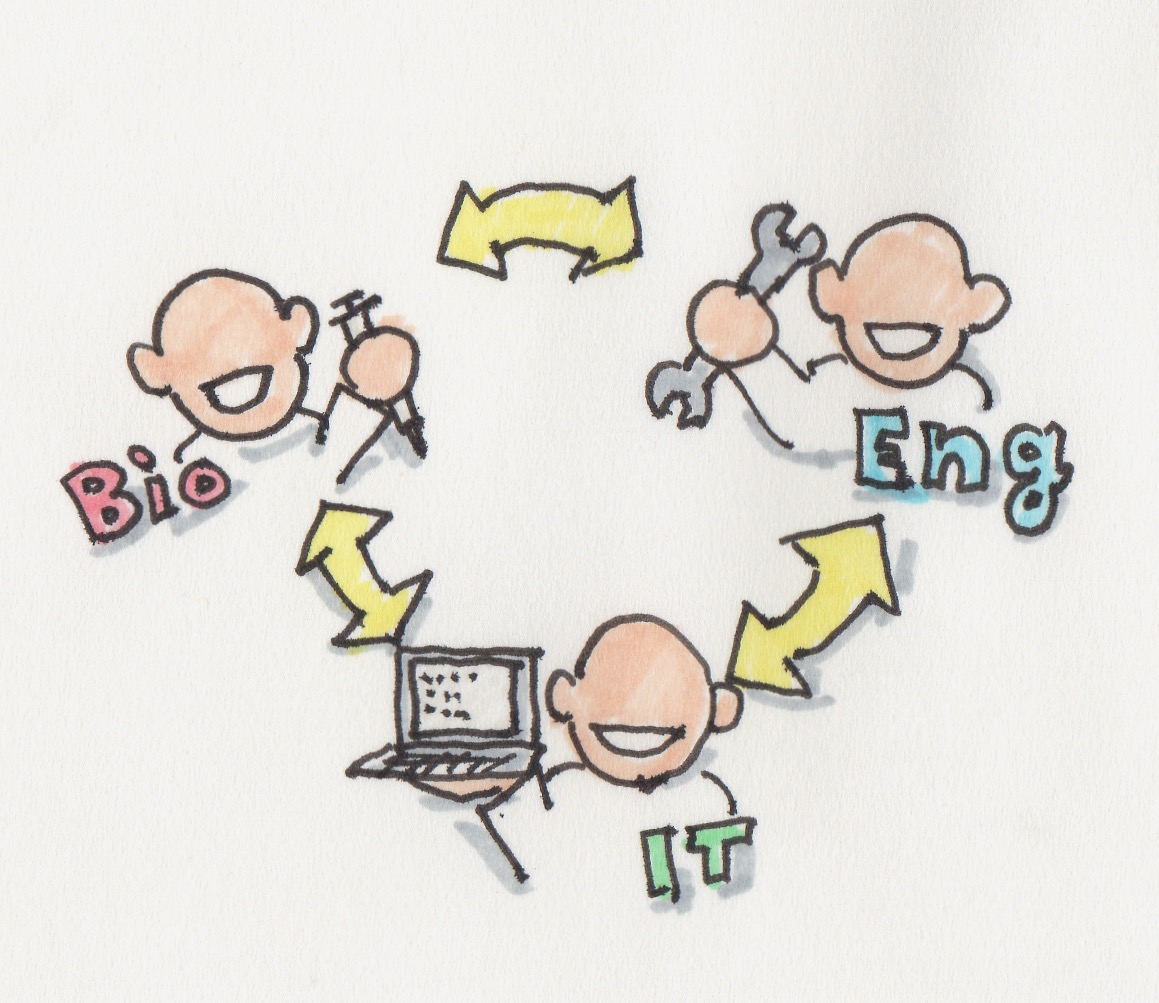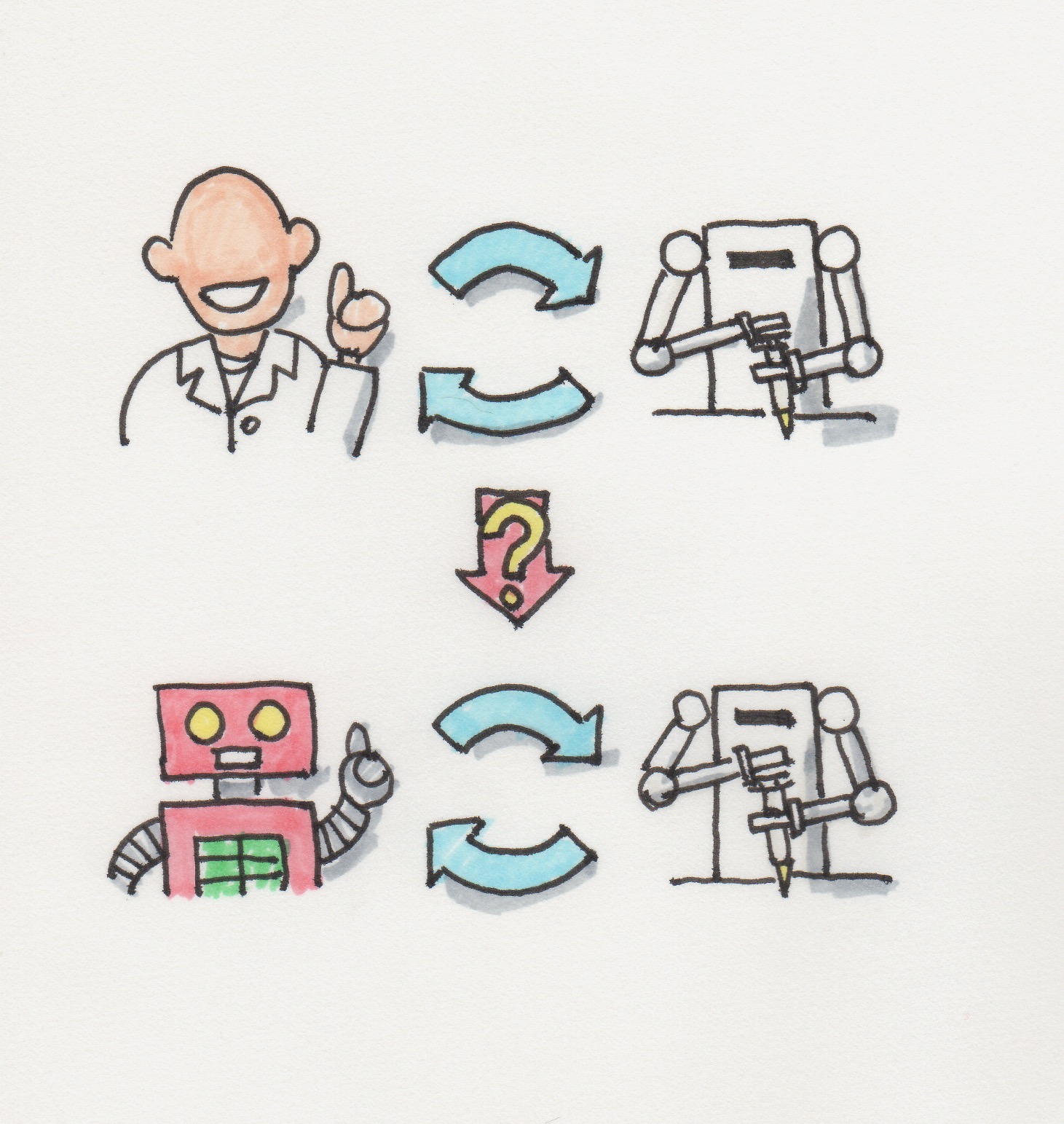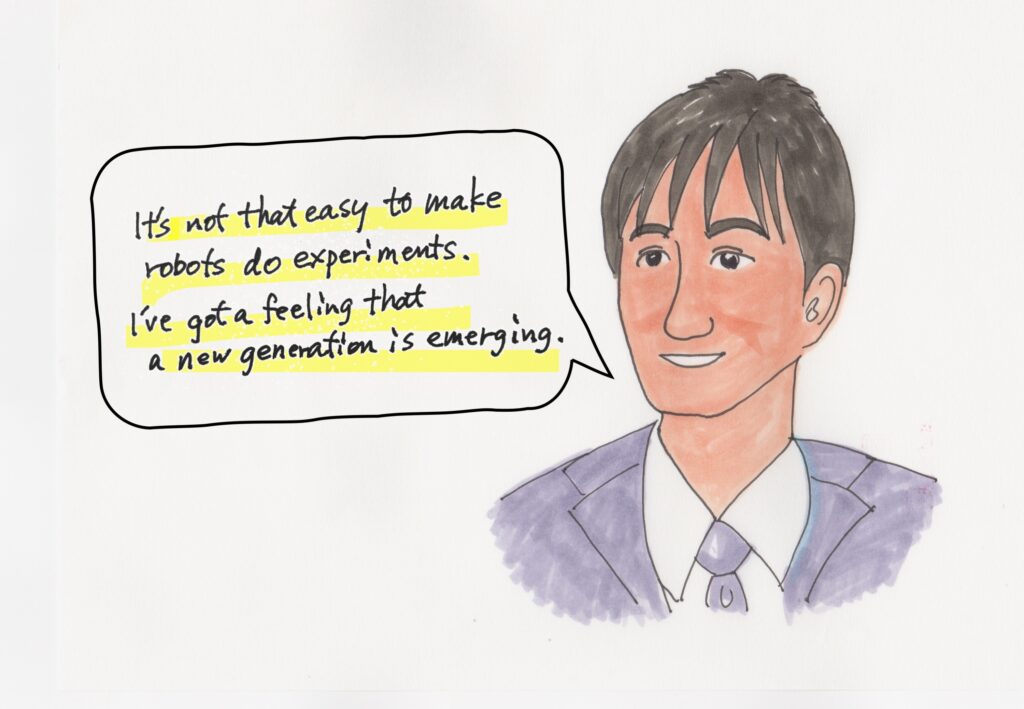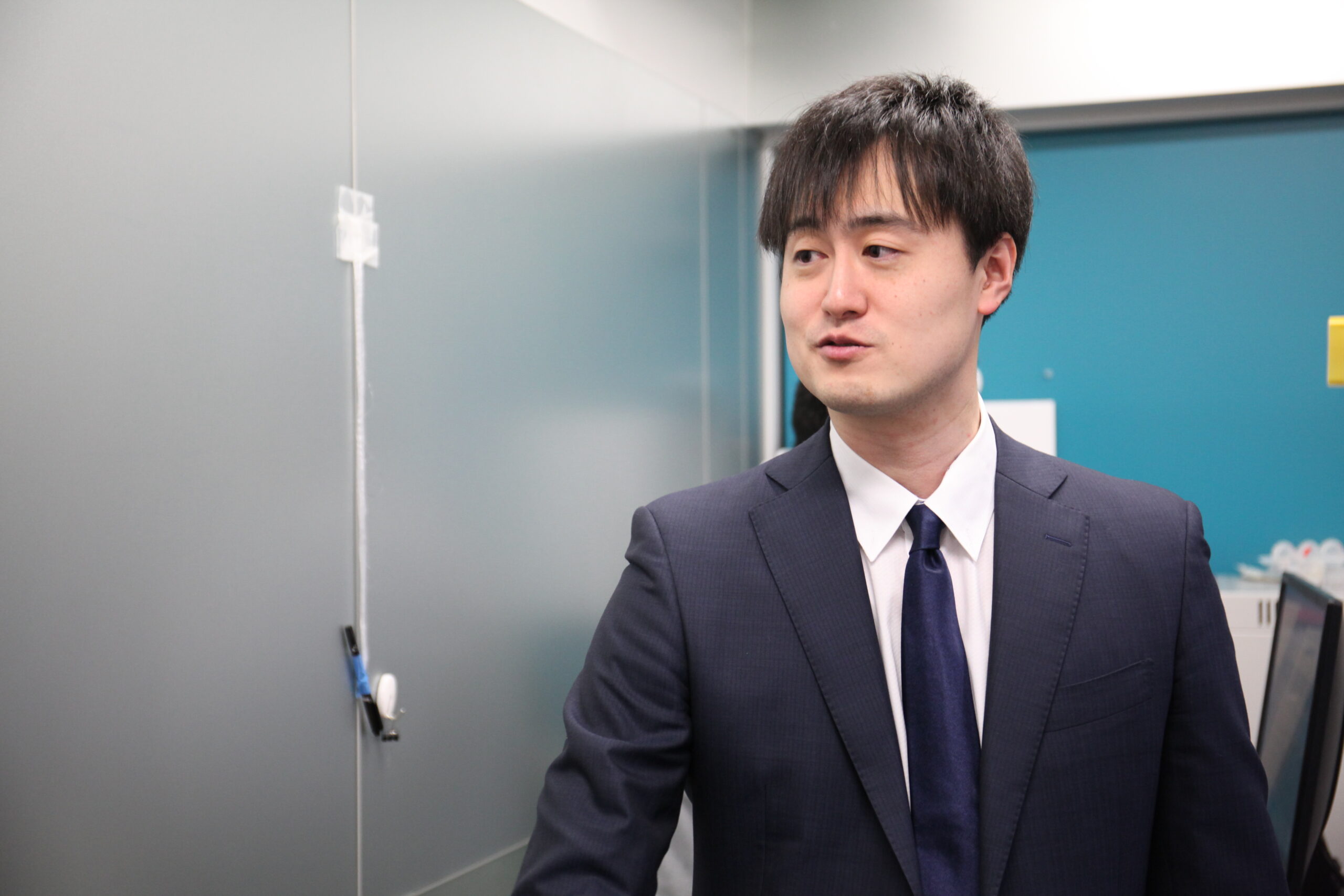A New Scheme of Science
We are going to meet Dr. Kanda, who is operating “Maholo,” a robot doing experiments. Although I have seen an online stream of Maholo in action, this is my first time seeing it in person.
I wonder what kind of themes we are going to talk about today…
Robot running experiments
I imagined that the moving robot would be making a lot of noise, but in fact, it moves relatively quietly.
That’s because the robot is culturing cells, so it needs to move slowly. The noise from the fans is also quite loud. The robot can move a lot faster as well, and when it does, it makes more noise.
How do you send commands to Maholo?
Details of the movements are already programmed within each command, so we just enter instructions like, “transfer 100 μL of liquid A to tube 2.”
Its movements are a bit creepy…
Maholo has seven joints in its arm, which makes its movements look a bit odd. But these joints also allow it to carry out a range of motions including raising both arms over its body to do experiments on a high shelf.
It’s not easy to make robots conduct experiments
What part of the implementation process to robots is difficult?
Although there are slight lot-to-lot variations of plastic products like tubes and pipette tips, these small discrepancies can be overridden by making adjustments in movements, such as pressure or angle. In fact, these types of adjustments are know-how that we have been accumulating.
To be honest, it’s hard to say that “everything can be done with robots.” There are in fact many other factors that need to be adjusted besides the robots. Soft, flexible items, such as cords, hoses and paper, are also still difficult for robots to handle. There is a lot of human know-how that needs to be translated to robots when we consider biological experiments.
Since we need to consider what robots can do and their limitations, we cannot transfer the exact same process that humans undertake to robots. We need to prioritize every single step in the process. During the implementation process, we need to be aware of what robots can and cannot do, as well as what can and cannot be done with IT. We also need to understand biology, such as knowing that enzymes cannot be left out in the open for a long time. We need to understand all of these things, otherwise the transfer process cannot be implemented.
So, you mean that we need a person who serves as sort of a knowledge hub—someone who knows both sides?

There is probably no single person on this planet right now who is completely knowledgeable in both robotics and molecular biology. It’s impossible to find someone like that right away, so the best we can do in the present situation is to ensure that we make a team in which the members are able to clearly communicate with each other.
This is a proof-of-concept experiment
It sounds like communication technology, rather than biology.
Basically, our research here aims to figure out the best way to set up a team for implementing experimental capabilities to a robot. In other words, we are not trying to make Maholo carry out specific tasks; rather, we are carrying out research to determine what steps should be taken and what kind of team is necessary when we want to use Maholo, AI or other robots to conduct experiments.
Even though Maholo is currently capable of doing many things, we still don’t know what is the most suitable way to use it in a biological lab. Addressing this challenge requires an assembly of people with different expertise such as robotics, IT and biology. We need to figure out what kind of team is needed to resolve day-to-day problems that might crop up.
It’s also important to consider how to communicate with one another, since these kind of teams involve a range of people with some working remotely. Even though nobody has determined the gold standard yet, we’ve been introducing tools and schemes that have worked in other fields, like IT.
So, what does science mean to human beings?
The images taken with a microscope can now be automatically uploaded to a network. We have almost implemented an automated system, in which AI can analyze those images and then plan the next experiment.
Does AI determine when to start as well?
That’s right. Of course, humans need to make the first decision of when to initiate an experiment. But once initiated, we don’t have to do anything. If we command the robot to “start the next experiment when cells are ready,” only the AI system knows when it decides the cells are “ready” to start the next experiment.
It sounds like something from a sci-fi movie… It makes you wonder, if AI and robots also become capable of making hypotheses, will humans be needed at all to do experiments?
It’s possible that humans may no longer be needed, if such a future comes to be. AlphaGo is a good example. Originally, AlphaGo was trained to become a strong Go player based on game records of a human player versus another human player, and in the second phase, it no longer learned from games played by humans. Instead, AlphaGo learned by playing games against itself, eventually becoming much, much stronger than even the world’s high-ranked professional human players.
This suggests that the science being carried out by humans may actually be quite biased and we are seeing only a very narrow image of a bigger picture.
The world would be completely different then, if that becomes the case.

But, it wouldn’t be limited just to research, you know.
Some might say that if there are no longer jobs in research, people can switch to listening or composing music or drawing pictures. But, it may not be as simple as that. In fact, AI systems capable of composing music and making drawings have been developed, and it’s hard to recognize that the end product was created by AI.
We are now realizing that such a future is near since AI and robots have come out into the real world. We are entering a phase in which we may need to reflect on one of the most fundamental themes of being human—what it means to be human.
Changing the world
There has not been much sharing of information on fundamental aspects, such as what points to keep in mind when using machines to run experiments. Thus, many researchers within Japan and around the world working in automation are facing similar troubles and hurdles. There are also some robots built for a particular purpose and used by only one lab. It can be challenging working on your own. So, we have begun to organize monthly study meetings which are held alternatingly in Tokyo and Osaka as a place for people to share their own experiences and hurdles. These meetups appear to be well received as once the next meeting is announced, spaces fill up fairly quickly.
It’s like a new research discipline, already…
In the future, I think it would be great to have a textbook of sorts that contains the experiences of the pioneers of biological automation—what they did and how they were able to implemented it. Once there is a textbook, this will become the first source of information for beginners. At the moment, there is no textbook.
For me, working closely with people with different expertise, from biologists, hardware developers and software developers, but who all have the same goal is a lot of fun, to say the least.
It seems that a new generation with a completely different mindset will arise in the future.
Yes, I too am expecting the emergence of a new generation with a different mindset from our generation, and in fact, I feel that they are already in the process of emerging. We are in the transition phase, which is like a sort of social experiment. So, our team is trying out as many things as we can imagine.

Postscript
It was an intense discussion. Actually, all of the interviews I’ve done for this series have been equally intense. I went into the interview thinking that we would just be touching on robots and AI, and didn’t expect to have discussions related to project management or the future. But as these new things become reality, and not just a conception, we are forced to think about them , regardless of whether we want to or not. Cars, electricity, telephones, the Internet, mobile phones, and smartphones. Coming up is AI and robots. I wonder what will be the thing that only humans can do…
